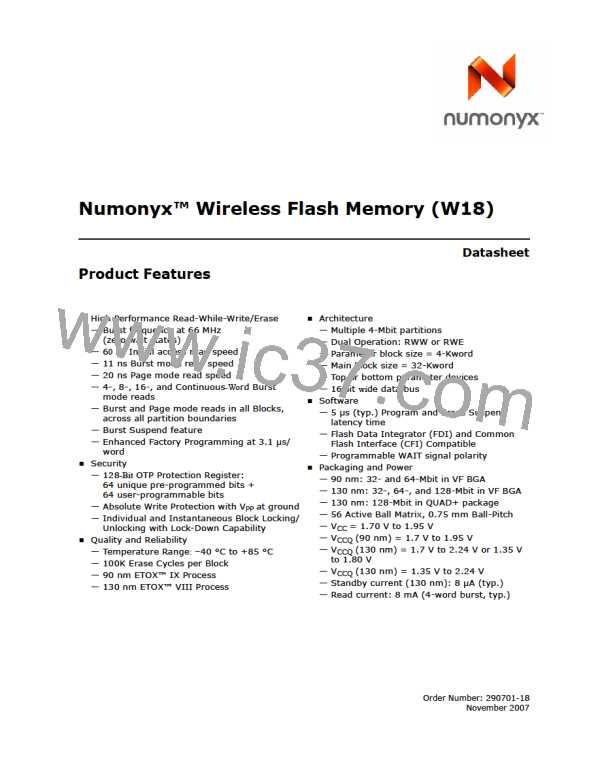Numonyx™ Wireless Flash Memory (W18)
Appendix B Common Flash Interface (CFI)
This appendix defines the data structure or “database” returned by the Common Flash
Interface (CFI) Query command. System software should parse this structure to gain
critical information such as block size, density, x8/x16, and electrical specifications.
Once this information has been obtained, the software will know which command sets
to use to enable flash writes, block erases, and otherwise control the flash component.
The Query is part of an overall specification for multiple command set and control
interface descriptions called Common Flash Interface, or CFI.
B.1
Query Structure Output
The Query database allows system software to obtain information for controlling the
flash device. This section describes the device’s CFI-compliant interface that allows
access to Query data.
Query data are presented on the lowest-order data outputs (DQ0-7) only. The
numerical offset value is the address relative to the maximum bus width supported by
the device. On this family of devices, the Query table device starting address is a 10h,
which is a word address for x16 devices.
For a word-wide (x16) device, the first two Query-structure bytes, ASCII “Q” and “R,”
appear on the low byte at word addresses 10h and 11h. This CFI-compliant device
outputs 00h data on upper bytes. The device outputs ASCII “Q” in the low byte (DQ0-7
)
and 00h in the high byte (DQ8-15).
At Query addresses containing two or more bytes of information, the least significant
data byte is presented at the lower address, and the most significant data byte is
presented at the higher address.
In all of the following tables, addresses and data are represented in hexadecimal
notation, so the “h” suffix has been dropped. In addition, since the upper byte of word-
wide devices is always “00h,” the leading “00” has been dropped from the table
notation and only the lower byte value is shown. Any x16 device outputs can be
assumed to have 00h on the upper byte in this mode.
Table 36: Summary of Query Structure Output as a Function of Device and Mode
Hex
Offset
Hex
Code
ASCII
Value
Device
00010
00011
00012
51
52
59
“Q”
“R”
“Y”
Device Addresses
November 2007
Order Number: 290701-18
Datasheet
89

 NUMONYX [ NUMONYX B.V ]
NUMONYX [ NUMONYX B.V ]